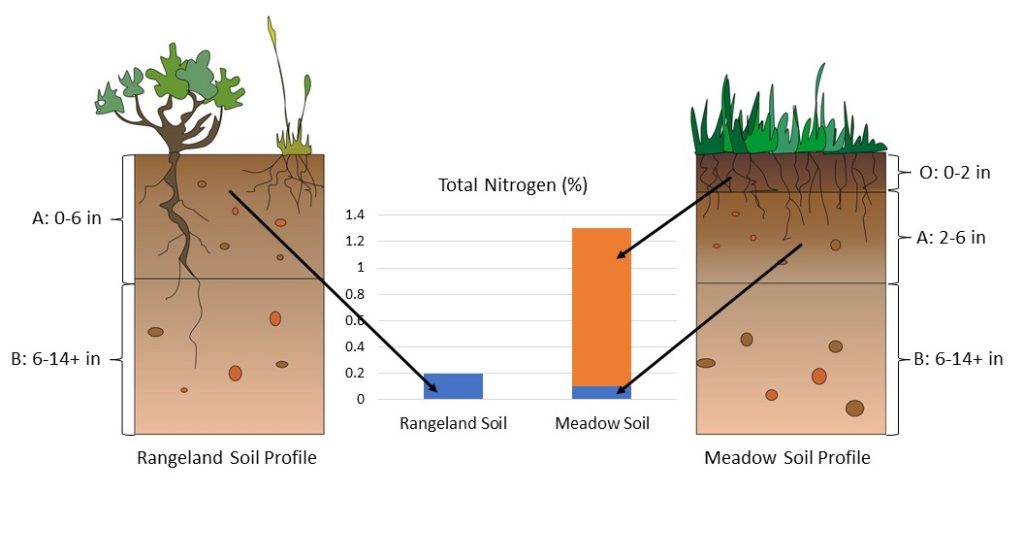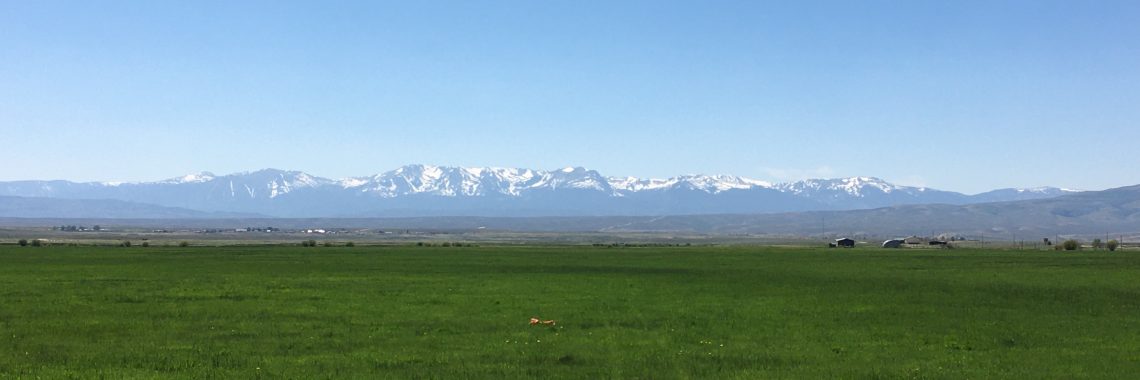Optimizing Mountain Meadow Management
Wyoming is famous for its harsh climate, and any local knows it’s something Wyomingites embrace with pride. Throughout our state’s history, the struggle with nature has created a special need for resiliency—a resiliency that might well describe many of Wyoming’s agricultural systems. It’s no wonder that ruminant animals, namely cattle and sheep, traditionally have been the cornerstone of Wyoming agriculture, with their ability to eke out a living on Wyoming’s vast grazing resources making them the ideal food producers on our state’s non-arable lands.
Early settlers quickly discovered, however, that maintaining animals through Wyoming winters requires stored forage and a lot of it—as much as 2–2.5 tons of hay per cow each year. For many ranchers today, this critical winter forage is produced on mountain hay meadows, areas of the landscape near rivers and streams where large swaths of grass hay are flood-irrigated with water from spring runoff. Meadows traditionally have been a low-input forage system that utilizes simple ditches and canals to expand the footprint of irrigable land near a water source. With the introduction of water, meadows developed naturally as water-loving sedges, rushes and grasses replaced hardy prairie vegetation, and after nearly a century, the continued influence of flood irrigation has shaped meadows as we know them today.
Although irrigating meadows increased the productive capacity of ranches, inefficient irrigation creates some unique management challenges. Meadows routinely remain saturated for weeks to months in the spring and early summer as forage grows prior to harvest. The excess water makes fertility management difficult, because fertilizers are subject to runoff, leaching and gaseous losses from the field. Early research found that, at best, the nitrogen-use efficiency of meadows caps out around 30%, and that meadows routinely respond to nitrogen fertilizer inputs. Low productivity means ranchers must balance management decisions to ensure they have enough hay available for the winter.
With recurring drought causing hay prices to skyrocket in recent months, and economic struggles of the pandemic causing fertilizer prices to double in just one year, it is time to reassess meadow management and sustainability. Here we share new ongoing research in the Departments of Ecosystem Science and Management and Plant Sciences that seeks to better understand meadow hay production for a new generation.
Meadow soils are unique
Early research on meadows focused on agronomic and economic management strategies to maximize forage production and value for livestock producers in the Mountain West. Studies of fertilizer response, grazing, harvest, and irrigation in the 1960s and 1970s provided the foundational meadow management tactics that still are in use today. An overriding theme in the early literature is that meadows are difficult to manage because of their unique soils, as influenced by flood irrigation. Researchers commonly described the surface horizon of meadow soils as being high in organic matter and stored nutrients that were of limited availablity to plants. This “thatch” or “sod-bound” layer developed because of the reduced decomposition of organic matter in the soil during saturated conditions, which in turn did not recycle nutrients for plant growth in subsequent years. Although researchers found as much as 1–2 tons per acre of organic nitrogen in the thatch layer, they acknowledged its unavailability as a disconnect in the nutrient cycling of meadow soils.
As Wyoming steps into a future of increasing demand for food production, it is critical to utilize every resource available for plant growth. Thus, our research began as an initial curiosity about the large amounts of stored nitrogen in meadow soils. We quickly realized the thatch layer, or specifically, the O-horizon (“O” signifying a high concentration of organic matter) needs to be examined more closely. We hypothesized that continuous flood irrigation has led to the development of an O-horizon that is limiting nitrogen availability for hay production, and that proper management can naturally release nitrogen from the system for increased plant growth.
After one year of data collection, we are finding evidence to support our hypothesis. In spring of 2021, we identified four local ranches that utilize flood irrigation for meadow hay production. At each ranch, we are comparing three unique agroecosystems: long-term fertilized, irrigated hay meadows; long-term unfertilized, irrigated hay meadows; and corresponding natural rangelands. By excavating the soil in all three agroecosystems, we confirmed that continuous flood irrigation leads to the development of an O-horizon in meadow soils.

To examine the O-horizon more closely, we sampled the O-horizon of meadows, the mineral soil directly beneath the O-horizon in meadows (called an A-horizon) and soil from adjacent rangelands lacking the influence of irrigation or an O-horizon (Figure 1). Results from spring and summer of 2021 confirm how the O-horizon has accumulated organic matter and nitrogen through time. The concentration of nitrogen in the O-horizon is higher than that of the A-horizon directly beneath. This also is the case for soil organic matter, meaning there is reduced decomposition of plant residue and organic matter in meadow soils, causing them to accumulate near the soil surface. This is not the case for rangeland soils, which have slightly higher organic matter and nitrogen than the A-horizon of meadows but do not accumulate carbon and nitrogen in an O-horizon (Table 1).

To test the potential for meadow soils to provide nitrogen for plant growth, in the lab we measured potentially mineralizable nitrogen, which is nitrogen in the soil that can be decomposed from organic matter into plant-available nitrogen in conditions ideal for microbial activity. Our results for PMN also confirm the abundance of stored nitrogen in meadow soils, because in the lab, the O-horizon is able to release large amounts of plant-available nitrogen (Table 1). If this is the case in the lab, then why aren’t meadows naturally releasing nitrogen for ample hay production in the field? Unfortunately, for a large part of the year, soil conditions in meadows are unfavorable for microbial activity and organic matter decomposition. Meadows often are located at high elevations where long, cold winters reduce microbial activity. Then, when conditions finally improve in spring and summer, excess irrigation water leaves the soil saturated and lacking oxygen, resulting in limited microbial metabolism, activity and nutrient release.
Future Research
Our results confirm that the O-horizon of meadow soils contains a large store of nitrogen that can be released for plant growth in ideal conditions, but the question remains, How can we naturally release nitrogen in the field? To answer this, our research team has initiated further work to determine management practices that promote decomposition and release of nitrogen from meadow soils. In fall of 2021, we initiated an experiment at the Laramie Research and Extension Center to examine tactics to disturb the O-horizon and stimulate nitrogen release using varying rotational grazing intensities and light tillage. We also hope to examine the effects of inter-seeding desirable legumes to increase natural nitrogen inputs to the system. Future results will help us analyze the feasibility of utilizing stored nitrogen for forage production on the field scale. Finally, we also plan to undertake a regional survey of meadow soils by sampling locations across Wyoming and Colorado. With a robust dataset, we expect to determine what is a “healthy” meadow soil, and what indicators are useful to better understand how to manage meadows for sustained forage production for years to come. Meadows have been woven into the history of Wyoming, and by researching them through a modern lens, we work to ensure they stay that way.
Daniel M. Adamson
Graduate Research Assistant, (307) 766-2263, esm@uwyo.edu
Jay Norton
Professor and Extension Soil Fertility Specialist, Department of Ecosystem Science and Management
Reprinted from the 2022 issue of Reflections, the College of Agriculture, Life Sciences and Natural Resources research magazine. This article is the received the Lynn Feltner Award for Best Student Paper, 2021.





